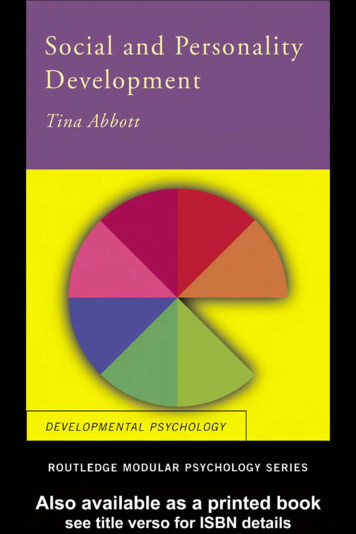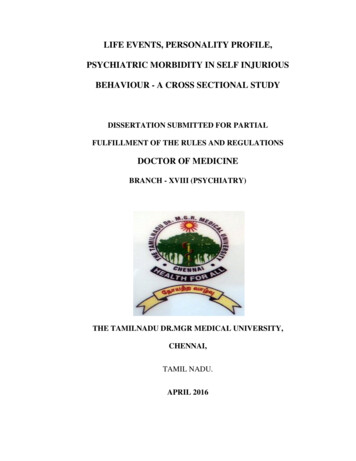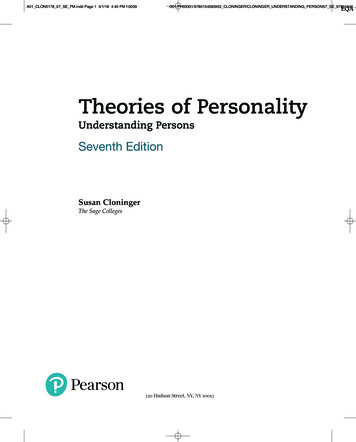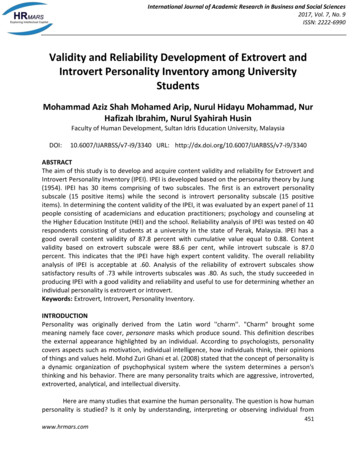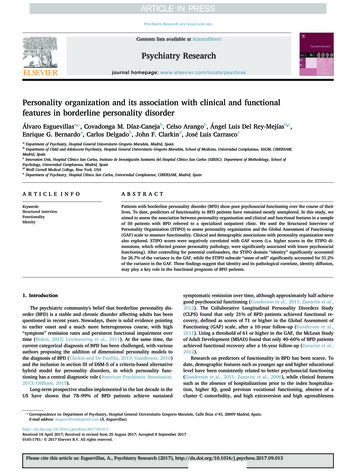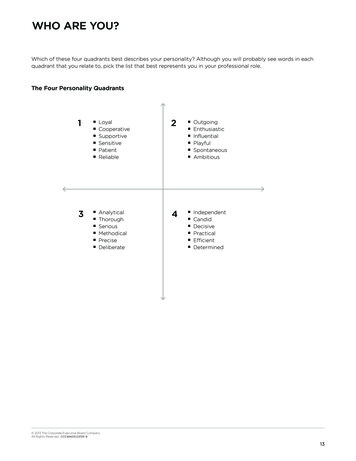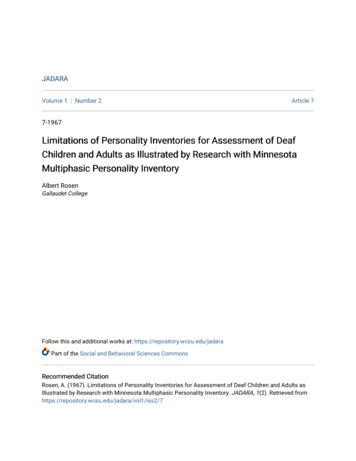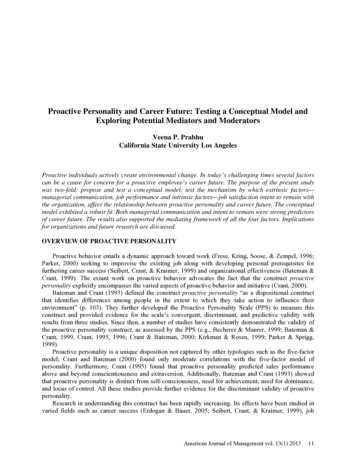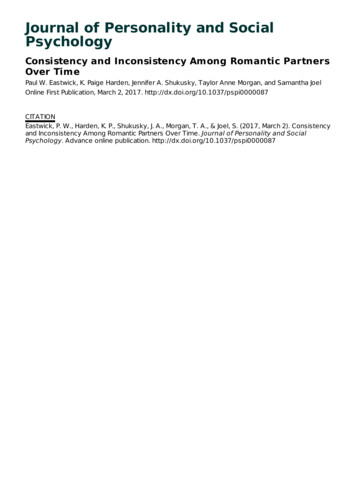
Transcription
Journal of Personality and SocialPsychologyConsistency and Inconsistency Among Romantic PartnersOver TimePaul W. Eastwick, K. Paige Harden, Jennifer A. Shukusky, Taylor Anne Morgan, and Samantha JoelOnline First Publication, March 2, 2017. ick, P. W., Harden, K. P., Shukusky, J. A., Morgan, T. A., & Joel, S. (2017, March 2). Consistencyand Inconsistency Among Romantic Partners Over Time. Journal of Personality and SocialPsychology. Advance online publication. http://dx.doi.org/10.1037/pspi0000087
Journal of Personality and Social Psychology2017, Vol. 1, No. 2, 000 2017 American Psychological Association0022-3514/17/ 12.00 http://dx.doi.org/10.1037/pspi0000087Consistency and Inconsistency Among Romantic Partners Over TimePaul W. EastwickK. Paige Harden, Jennifer A. Shukusky, andTaylor Anne MorganUniversity of California, DavisUniversity of Texas at AustinSamantha JoelThis document is copyrighted by the American Psychological Association or one of its allied publishers.This article is intended solely for the personal use of the individual user and is not to be disseminated broadly.University of UtahTheoretical perspectives on mating differentially emphasize whether (and why) romantic partner selection and maintenance processes derive from stable features of individuals (e.g., mate value, matepreferences, relationship aptitude) and their environments (e.g., social homogamy) rather than adventitious, dyad-specific, or unpredictable factors. The current article advances our understanding of this issueby assessing how people’s actual romantic partners vary on constructs commonly assessed in evolutionary psychology (Study 1), sociology (Study 2), and close relationships (Study 3). Specifically, wecalculated the extent to which the past and present partners of a focal person (i.e., the person who datedall of the partners) cluster on various measures. Study 1 investigated consistency in the observablequalities of the romantic partners, revealing substantial evidence for clustering on coder-rated attributeslike attractiveness and masculinity. Study 2 examined qualities self-reported by romantic partnersthemselves in a demographically diverse sample and found modest evidence for clustering on attributessuch as IQ and educational aspirations; however, clustering in this study was largely due to demographicstratification. Study 3 explored target-specific ratings by partners about the focal person and found littleevidence for clustering: The ability to elicit high romantic desirability/sexual satisfaction ratings frompartners was not a stable individual difference. The variables that affect mating may differ considerablyin the extent to which they serve as stable versus unpredictable factors; thus, the fields of evolutionarypsychology, sociology, and close relationships may reveal distinct depictions of mating because theconstructs and assessment strategies in each differ along this underappreciated dimension.Keywords: attraction, human mating, mate selection, romantic relationshipsSupplemental materials: ers across several scientific literatures examine howhumans select one another as mates and maintain those mateshipsover time. However, the disciplines’ depictions of this process donot always cleanly intersect; it would not be unusual to encountera few papers from each of the evolutionary psychological, sociological, and close relationships literatures and marvel at how theyall describe mating in a single species rather than two or threedifferent species. Is Homo sapiens a species that exhibits pro-nounced observable differences in romantic desirability, as emphasized by evolutionary psychological perspectives on matevalue (Kavanagh, Robins, & Ellis, 2010; Kenrick, Groth, Trost, &Sadalla, 1993; Penke, Todd, Lenton, & Fasolo, 2007), a specieswhose partner choices are shaped by economic and demographiccontexts, as emphasized by sociological perspectives on assortative mating (Burgess & Wallin, 1953; Kalmijn, 1998; Schwartz &Mare, 2012), or a species in which mating decisions are driven byPaul W. Eastwick, Department of Psychology, University of California,Davis; K. Paige Harden, Department of Psychology and Population Research Center, University of Texas at Austin; Jennifer A. Shukusky andTaylor Anne Morgan, Department of Human Development and FamilySciences, University of Texas at Austin; Samantha Joel, Department ofPsychology, University of Utah.This research was supported in part by National Science FoundationGrant BCS-1243323 awarded to Paul W. Eastwick. Any opinions, findings,and conclusions or recommendations expressed in this material are those ofthe authors and do not necessarily reflect the views of the National ScienceFoundation. We thank the following research assistants: Norin Ali, Christine Edomwande, Raynor Fisher, Nathan Gibson, Kevin Ly, Tania Nguyen,Christine Nott, Alex Powell, Eden Stone, Josephina Thibodeaux-Guillory,and Lisa Truong. This research uses data from Add Health, a programproject directed by Kathleen Mullan Harris and designed by J. RichardUdry, Peter S. Bearman, and Kathleen Mullan Harris at the University ofNorth Carolina at Chapel Hill and funded by Grant P01-HD31921 from theEunice Kennedy Shriver National Institute of Child Health and HumanDevelopment, with cooperative funding from 23 other federal agencies andfoundations. Special acknowledgment is due to Ronald R. Rindfuss andBarbara Entwisle for assistance in the original design. Information on howto obtain the Add Health data files is available on the Add Health website(http://www.cpc.unc.edu/addhealth). No direct support was received fromGrant P01-HD31921 for this analysis.Correspondence concerning this article should be addressed to Paul W.Eastwick, Department of Psychology, University of California, Davis, OneShields Avenue, Davis, CA 95616. E-mail: eastwick@ucdavis.edu1
This document is copyrighted by the American Psychological Association or one of its allied publishers.This article is intended solely for the personal use of the individual user and is not to be disseminated broadly.2EASTWICK, HARDEN, SHUKUSKY, MORGAN, AND JOELsubjectively biased perceptions of a specific partner, as emphasized by close relationships perspectives on relationship maintenance (Le, Dove, Agnew, Korn, & Mutso, 2010; Murray, Holmes,& Griffin, 1996; Rusbult, Olsen, Davis, & Hannon, 2001)? Theclear answer is “all of the above” and will require an extensiveintegrative effort.In most cases, the scientific conclusions that follow from evolutionary, sociological, and close relationships perspectives mayall be correct yet nonintersecting because the disciplines (a) studydifferent constructs and (b) use different analytical approaches. Forexample, common methodological approaches include the study ofobservable, desirable qualities (e.g., attractiveness) using photographs in the evolutionary psychological literature (Little, Jones, &DeBruine, 2011), the study of demographically variable constructs(e.g., education level) using self-report surveys or interviews in thesociological literature (Schwartz & Mare, 2012), and the study ofpeople’s subjective reports (e.g., relationship satisfaction) about aspecific other person, usually a romantic partner, in the closerelationships literature (Fletcher, Simpson, & Thomas, 2000b).Given these methodological choices, it should come as little surprise that the depictions of mate selection processes in the threedisciplines emphasize observable desirability, demographic sorting, and partner-specific biases, respectively. Furthermore, thesemethods may be driving theory rather than vice versa, becausedepending on which literature one peruses, it would be easy toconclude from prominent theories that human mating is fundamentally located in stable features of the individual, stable features ofthe environment, or time- and context-sensitive features of dyads.One approach that may aid in the long-term goal of integratingthese perspectives is to use a single analytic strategy that can beapplied to any and all of these different types of variables—that is,one could study the constructs common in all three literatures buthold constant the data analytic approach. This manuscript pioneersthe use of such a data analytic strategy: calculating the extent towhich a person’s current and former romantic partners cluster (i.e.,are more similar to one another than would be expected due tochance) on particular variables of interest. We use this strategy toaddress a substantive question inherent to all three disciplines: Towhat extent are a person’s romantic choices driven by stablefeatures of the chooser and his or her environment rather thanfactors that shift from relationship to relationship or are fundamentally unpredictable (Lykken & Tellegen, 1993)? We raise thisquestion not in an attempt to garner support for the theoreticalperspectives of one literature over another. Rather, we assume thatscientists want to explain how people choose romantic partners inthe real world, and therefore they endeavor to understand howobservable features, demographics, and relationship-specific judgments factor into this process. Given this goal, the extent ofclustering offers useful clues about where the largest causal forcesare likely to reside (e.g., stable vs. unstable factors) for a givenconstruct of interest.Data sets addressing the extent of clustering in partner choicesover time are rare and challenging to collect. Whereas dyadic dataare common in the close relationships field, dyadic data derivingfrom a given focal person’s multiple romantic partnerships arenearly nonexistent (for one exception, see Robins, Caspi, & Moffitt, 2002). The current manuscript contains three studies thatovercome this hurdle, and each examines constructs that largelycorrespond to one of the three literatures. Study 1 finds moderate-to-strong evidence for clustering on immediately observable variables (e.g., attractiveness) common in the evolutionary psychological literature. Study 2 finds qualified evidence for clustering ondemographic variables (e.g., educational aspirations) common inthe sociological literature. Finally, Study 3 finds little evidence forclustering on—and thus little evidence that stable forces affect—partner-specific judgments (e.g., romantic desire reports about apartner) that are common in the close relationships literature. Wealso present a simulation study demonstrating that, in principle,clustering can emerge from active partner selection processesalone, even when the number of observed partners in the dataset issmall (i.e., two partners per focal person). We conclude with adiscussion of how the current results and similar investigationsmight help to unify these different perspectives on mating.Stable Influences on Romantic Partner ClusteringThe people with whom we could form relationships might differfrom the people with whom we do form relationships, and thiscomparison can reveal important insights about the processesunderlying human mating. If people selected romantic partners atrandom, then the current and former partners of a given focalperson would be no more similar to one another than to any otherindividual in the population. In contrast, if predictable, stablefactors bring dyads together beyond chance alone, a focal person’sromantic partners will cluster, which means that they will exhibitsimilarities that are not shared with other individuals who havenever been the focal person’s relationship partner. For example,nonrandom, stable factors such as a focal person’s own attributes(e.g., their own intelligence), mate preferences (e.g., a preferencefor intelligent partners), and consistent environments (e.g., livingnear intelligent people) will cause a focal person’s current andformer romantic partners to possess similar attributes (e.g., highintelligence). These same forces could also cause clustering in theratings provided by the current and former partners about the focalperson: A focal person’s desirable qualities should cause his or herpartners to provide similar ratings about his or her romanticdesirability. The extent to which current and former romanticpartners cluster on a given attribute, therefore, denotes the upperlimit on the extent to which factors that are consistent across time(e.g., a focal person’s stable attributes, personality, or living context) influence mating with respect to that attribute.1Active Stable FactorsMany prominent theories of human mating predict that people’sstable qualities cause them to select some partners over others—aprocess that should produce clustering. Furthermore, much of thisselection process is presumed to be active, which means that itemerges as individuals (a) evaluate and/or (b) are evaluated by1The assessment strategy used in the present article examines clusteringone trait at a time, so a low level of clustering would mean that factors thatare consistent across time have weak effects on that particular attribute.Moreover, if variables that are largely or completely unassociated withmating (e.g., day of the week someone was born, middle initial) failed toexhibit clustering, this finding would have negligible implications for thetheoretical perspectives discussed here. For this reason, all variables examined in this article have been linked extensively to human mating in oneor more literatures in prior research (supplementary Table 1).
This document is copyrighted by the American Psychological Association or one of its allied publishers.This article is intended solely for the personal use of the individual user and is not to be disseminated broadly.CONSISTENCY IN ROMANTIC PARTNERSpotential partners in their immediate social milieu. Several examples of these theories follow: First, evolutionary perspectives suggest that some people have greater mate value than others (i.e.,they possess traits that would promote a partner’s reproductivesuccess; Sugiyama, 2005), and people high in mate value shouldbe better than people low in mate value at attracting and retainingpartners with desirable qualities (Ellis & Kelley, 1999; Kirsner,Figueredo, & Jacobs, 2003; Penke et al., 2007). In other words,individual differences in a focal person’s mate value should causeclustering among current and former partners in terms of thepresence or absence of normatively desirable traits, such as physical attractiveness, appealing personality traits, or intelligence.Second, evolutionary and close relationships perspectives suggestthat people also possess idiosyncratic mate preferences for particular qualities in romantic partners— qualities that are desirable tosome people but not to others (Buss & Barnes, 1986; Fletcher,Simpson, Thomas, & Giles, 1999). If people select partners whoare congruent with their mate preferences, then clustering shouldalso emerge for idiosyncratically desirable traits: For example,people with a preference for energetic, adventurous partnersshould be more likely than people without this preference to dateenergetic, adventurous partners. Third, similarity-attraction effects(Buston & Emlen, 2003; Byrne, 1961; Montoya, Horton, & Kirchner, 2008) should also produce clustering among current andformer partners: Even if people are unaware whether they do or donot have preference for religiosity, clustering on religiosity willemerge if people tend to be drawn to similar others. Finally, in therelationship maintenance domain, some people might have greaterrelationship aptitude than others as a function of their particularpersonality traits or personal histories (e.g., neuroticism, attachment anxiety), and this aptitude would cause clustering to emergefor partners’ target-specific judgments of a focal person (Finkel,Eastwick, Karney, Reis, & Sprecher, 2012). For example, somepeople may be better able to resolve conflict and respond empathically to their partners, and these abilities should in turn make theirpartners similarly satisfied or unsatisfied in their relationship withthe person.No prior studies have assessed clustering among a single focalperson’s multiple romantic partners over time; nevertheless, theexistence of assortative mating strongly implies that clusteringshould occur. For example, the two members of a romantic pairtend to sort with respect to appearance—most notably physicalattractiveness (Feingold, 1988)—as well as other desirable qualities like intelligence (Watson et al., 2004). Researchers continue toinvestigate whether factors like mate value or mate preferences canexplain the extent to which partners sort on these qualities (Burriss,Welling, & Puts, 2011a, 2011b; Conroy-Beam & Buss, 2016;DeBruine et al., 2006; Hunt, Eastwick, & Finkel, 2015; Kalick &Hamilton, 1986). Yet as long as the underlying causal factors, likemate value, exhibit at least modest stability as people move fromrelationship to relationship, then the same factors that produceassortative mating should produce clustering in a person’s romantic partners over time. In other words, if (a) a man’s observablemate value when he selects partner A correlates positively with hisobservable mate value when he later selects partner B, and (b)mate value produces assortative mating (i.e., high mate valueindividuals successfully attract other high mate value individuals),then (c) partner A and partner B should cluster on mate value.3Passive Stable FactorsEven in the absence of an active psychological selection process, passive yet stable factors—factors that affect which datingpartners a focal person has the opportunity to meet—may alsoproduce clustering. For example, social homogamy perspectivesnote that some portion of the mate selection process originates inthe social milieu that surrounds each individual. People are morelikely to meet and date others who live nearby and whom theyencounter frequently (Belot & Francesconi, 2013; Festinger,Schachter, & Back, 1950; Luo & Klohnen, 2005; Newcomb,1961), and people tend to live near others who are similar to themwith regard to income, educational attainment, and race. Theschools that adolescents and young adults attend are especiallyimportant sorting factors in this regard (Mare, 1991). Becauseyoung people’s acquaintances are highly likely to attend the sameschool, the extent to which attributes cluster at the school levelshould also affect the clustering of acquaintances and, subsequently, clustering of romantic partners. In other words, the tendency for people to meet others who are similar to them by virtueof their living situation will produce clustering among romanticpartners (Mascie-Taylor & Vandenberg, 1988). Although socialhomogamy forces are relatively passive and do not imply that afocal person exerts any predictable choice of romantic partnerswithin his or her immediately available pool of partners, they maynevertheless have large effects on producing clustering. Indeed,just as with the active forces described above, the existence ofassortative mating on variables that differ across demographiccontexts (e.g., education, religiosity; Watson et al., 2004) stronglyimplies that clustering should emerge among a focal persons’current and past romantic partners with respect to these variables.Adventitious Perspectives on RomanticPartner ClusteringFor many constructs, clustering among romantic partners couldbe quite substantial. But other perspectives emphasize how muchof the mate selection process in humans may be driven by chance,unpredictable forces not rooted in stable characteristics of individuals or their environments. In some contexts, the active selectionfactors described above may be quite weak. For example, once aface-to-face interaction has occurred, there is no replicable evidence that people are more likely to select mates who match ratherthan mismatch their preferences for a particular attribute (Eastwick, Luchies, Finkel, & Hunt, 2014a; cf. Campbell, Chin, &Stanton, 2016). With respect to mate value, agreement amongopposite sex acquaintances in terms of who does and does notpossess mate value is extremely low, so consensual mate valuemay not have a strong influence on mate selection in the casewhere romantic partners get to know each another before forminga relationship (Eastwick & Hunt, 2014). Finally, the similarity–attraction effect tends to be weak in face-to-face initial attractionsettings (Luo & Zhang, 2009), as well as in established relationships (Watson et al., 2004). Although stable forces such as matepreferences and mate value are surely influential under somecircumstances (e.g., when perusing online dating profiles; Eastwick et al., 2014a), the extent to which they account for variancein determining whom people actually select as romantic partnersremains unclear.
This document is copyrighted by the American Psychological Association or one of its allied publishers.This article is intended solely for the personal use of the individual user and is not to be disseminated broadly.4EASTWICK, HARDEN, SHUKUSKY, MORGAN, AND JOELThese alternative perspectives on partner selection do not implythat the underlying process is atheoretical and random. Rather,stable influences on romantic outcomes will appear to be weak tothe extent that romantic selection processes are highly dyadic,synergistic, or contextual. For example, mate preferences for traitsmay not generate clustering because traits change their meaningdepending on the context of a partner’s overall constellation oftraits (Eastwick, Finkel, & Eagly, 2011). Akin to context effects inclassic person perception research (Asch, 1946), people may notconsistently select romantic partners who have a particular traitbecause a trait that that makes one partner appear desirable maymake another partner seem undesirable. Furthermore, mate valuejudgments consist of large amounts of idiosyncratic variance (i.e.,relationship variance; Eastwick & Hunt, 2014), and thus a wonderful partner for one person might be a terrible partner for anotherperson, irrespective of consensual mate value. Myriad theories ofclose relationships are consistent with this conceptualization of themate selection process—theories that highlight the importance ofthe dyad (e.g., Kelley et al., 2003), the way that relationships growand change over time (e.g., Hazan & Shaver, 1994; Karney &Bradbury, 1995), and how idiosyncratic factors have large influences on relationship outcomes and yet are largely unknowablebefore two people meet and get to know each other (Eastwick,2016; Eastwick, Keneski, Morgan, & MacDonald, 2016; Finkel etal., 2012). Many complex social processes can be predicted onlyweakly from distal predictors alone (e.g., economic fundamentalspoorly predict election outcomes; Lauderdale & Linzer, 2015;Silver, 2012); romantic partner selection and maintenance processes may be similarly difficult to predict from trait informationand other self-reported qualities.Another source of data suggesting that human mating is largelygoverned by adventitious factors derives from twin data (Lykken& Tellegen, 1993). Although many qualities of the spouses oftwins are correlated (e.g., the church activities of cotwins’ spousescorrelate at approximately r .30), these correlations do not differbetween monozygotic twins and dizygotic twins. This patternstands in marked contrast to other preferences and choices (e.g.,jobs, leisure activities, friends), which typically show greater correlations among monozygotic than dizygotic twins (Bouchard,Lykken, McGue, Segal, & Tellegen, 1990). In other words, thelack of a difference between monozygotic and dizygotic twins’partner choices (as evidenced by their similarity levels) suggeststhat the internal, genetically influenced processes that affect manydifferent kinds of life choices apply only weakly to the choice ofa mate (see also Zietsch, Verweij, Heath, & Martin, 2011). Informed by these findings, Lykken and Tellegen (1993) proposedthat successful reproduction in ancestral environments primarilydepended on forming and maintaining a strong pair-bond, notselecting the best possible mate (see also Hazan & Diamond,2000).The Current ResearchThe similarity inherent to a person’s unique pool of romanticpartners, past and present, denotes the extent to which mate selection on a given attribute is governed by stable, predictable factors,both active (e.g., mate preferences) and passive (e.g., social stratification). Surprisingly, the extent of similarity has not been previously calculated with respect to any attribute, perhaps because ofthe challenges inherent in an analytic strategy that requires information provided by multiple romantic partners. One study examined participants’ own reports of relationship experiences with twodifferent partners at two different points in time (Robins et al.,2002), but partners were themselves recruited to participate at onlyone time point, so no self-reported or objective qualities of themultiple partners were available to calculate clustering.The current set of studies addresses this critical gap in the mateselection literature, and it represents an initial attempt to quantifythe extent to which partner choice is predictable with respect toseveral different romantic partner attributes. First, a SimulationStudy uses agent-based modeling to test whether active mateselection strategies would result in empirically detectable clustering in data sets that sampled a restricted number of mates (2– 4) foreach individual. Next, we present results from three empiricalstudies. Study 1 examines clustering among focal persons’ currentand former partners in terms of traits that are observable from thepartners’ photographs. After all, people can tell a great deal aboutanother person from a photograph, and evolutionary psychologistshave capitalized on this feature in their study designs, which havefrequently emphasized desirable traits such as attractiveness, masculinity, and dominance (e.g., Bailey, Durante, & Geary, 2011;Burriss et al., 2011a, 2011b; Fink & Penton-Voak, 2002; Little etal., 2011; Maner, Dewall, & Gailliot, 2008; Rhodes, 2006; Zietsch,Lee, Sherlock, & Jern, 2015). Study 2 uses data from a large,nationally representative, longitudinal study of adolescents andyoung adults: the National Longitudinal Survey of AdolescentHealth (Add Health; Harris & Udry, 1994 –2008). This surveyincluded several traits related to romantic desirability that wereself-reported by the current and former partners of focal persons,and because some of the traits vary across demographic contexts(e.g., IQ), we could quantify the extent to which clustering forthese variables is a function of active versus passive selectionforces. Study 3 addresses whether clustering emerges with respectto target-specific reports—the most common assessment strategyin the close relationships literature (Fletcher et al., 2000b)— bydrawing from an Internet database containing women’s ratings ofmen whom they were currently dating or had dated in the past.In all three studies, the data sets can be organized such thatromantic partners are nested within focal person—the participantwho chose to date all of those partners. The intraclass correlations(ICC) for the focal person capture the extent to which qualities ofromantic partners cluster. For example, the focal person intraclasscorrelation for intelligence indicates the extent to which focalpersons consistently dated intelligent versus unintelligent partnersacross time. This consistency across current and former partnerscould be attributable to the focal person’s mate value (possessingnormatively desirable characteristics that make one better able toattract intelligent partners), the focal person’s mate preferences(prioritizing intelligence over other attributes in mating decisions),similarity-attraction (intelligent people are more likely to dateother intelligent people), or social homogamy (a person’s pool ofpotential mates is drawn from an educational context that isstratified by intelligence). With respect to target-specific reports(Study 3), consistency across current and former partners couldalso be attributable to the focal person’s relationship aptitude(some focal persons have relationship skills that cause their partners to rate them as desirable; Finkel et al., 2012).
This document is copyrighted by the American Psychological Association or one of its allied publishers.This article is intended solely for the personal use of the individual user and is not to be disseminated broadly.CONSISTENCY IN ROMANTIC PARTNERSAs the discussion above highlights, clustering should emerge onvariables that people generally want in their partners (e.g., anyconstruct that taps mate value or relationship aptitude), variablesthat some people want more than others (e.g., any construct thatexhibits idiosyncratic differences in mate preferences), or variableson which people sort based on location (e.g., any construct linkedto social homogamy). All of the constructs examined in the presentset of studies are linked to at least one of these perspectives—thatis, each variable (a) is desired by people in general, (b) is desiredby some people more than others, and/or (c) is related to demographic sorting. Furthermore, each variable has strong theoreticalconnections to one or more of the evolutionary psychological,sociological, and close relationships perspectives, and each hasbeen examined frequently in a mating-relevant context using thesame assessment strategy (e.g., rated from a photograph, selfreported) in prior research (except the number of positive/negativequalities variables in Study 3, see supplementary Table 1).Simulation StudyIn this simulation study, we sought to ensure that our dataanalytic strategy is, in fact, able to detect effects of stable influences on romantic clustering. In the studies that follow, the average number of partners per focal person is approximately four inStudy 1, two in S
Journal of Personality and Social Psychology Consistency and Inconsistency Among Romantic Partners Over Time Paul W. Eastwick, K. Paige Harden, Je
